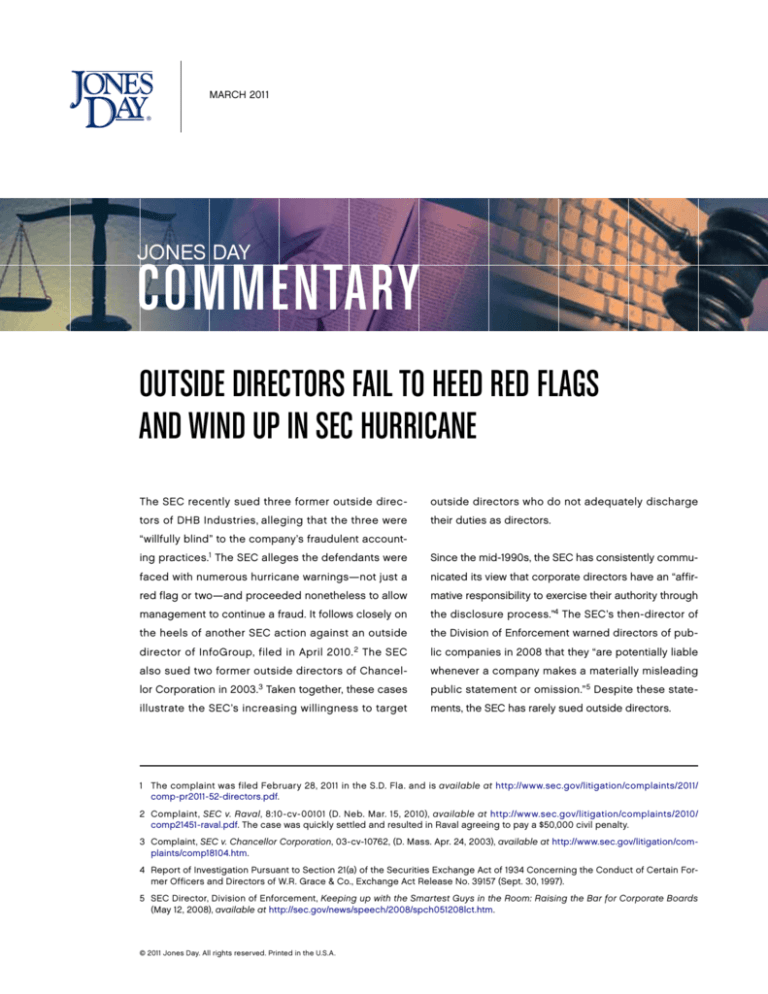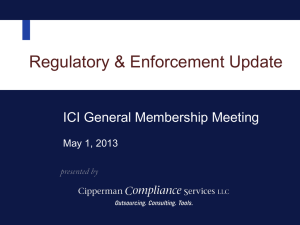
March 2011
JONES DAY
COMMENTARY
Outside Directors Fail to Heed Red Flags
and Wind Up in SEC Hurricane
The SEC recently sued three former outside direc-
outside directors who do not adequately discharge
tors of DHB Industries, alleging that the three were
their duties as directors.
“willfully blind” to the company’s fraudulent accounting practices.1 The SEC alleges the defendants were
Since the mid-1990s, the SEC has consistently commu-
faced with numerous hurricane warnings—not just a
nicated its view that corporate directors have an “affir-
red flag or two—and proceeded nonetheless to allow
mative responsibility to exercise their authority through
management to continue a fraud. It follows closely on
the disclosure process.”4 The SEC’s then-director of
the heels of another SEC action against an outside
the Division of Enforcement warned directors of pub-
2010. 2
The SEC
lic companies in 2008 that they “are potentially liable
also sued two former outside directors of Chancel-
whenever a company makes a materially misleading
director of InfoGroup, filed in April
lor Corporation in
2003.3
Taken together, these cases
illustrate the SEC’s increasing willingness to target
public statement or omission.” 5 Despite these statements, the SEC has rarely sued outside directors.
1 The complaint was filed February 28, 2011 in the S.D. Fla. and is available at http://www.sec.gov/litigation/complaints/2011/
comp-pr2011-52-directors.pdf.
2 Complaint, SEC v. Raval, 8:10-cv-00101 (D. Neb. Mar. 15, 2010), available at http://www.sec.gov/litigation/complaints/2010/
comp21451-raval.pdf. The case was quickly settled and resulted in Raval agreeing to pay a $50,000 civil penalty.
3 Complaint, SEC v. Chancellor Corporation, 03-cv-10762, (D. Mass. Apr. 24, 2003), available at http://www.sec.gov/litigation/complaints/comp18104.htm.
4Report of Investigation Pursuant to Section 21(a) of the Securities Exchange Act of 1934 Concerning the Conduct of Certain Former Officers and Directors of W.R. Grace & Co., Exchange Act Release No. 39157 (Sept. 30, 1997).
5 SEC Director, Division of Enforcement, Keeping up with the Smartest Guys in the Room: Raising the Bar for Corporate Boards
(May 12, 2008), available at http://sec.gov/news/speech/2008/spch051208lct.htm.
© 2011 Jones Day. All rights reserved. Printed in the U.S.A.
Consequently, many took notice in 2003 when the SEC
According to the SEC’s Complaint, the three directors
brought an enforcement action against two former outside
ignored numerous red flags regarding inventory control defi-
directors of Chancellor Corporation. More recently, in April
ciencies. The company’s auditor resigned in protest in 2003
2010, the SEC brought charges against Vasant Raval, a for-
and issued a material weakness letter to the Audit Commit-
mer director of InfoGroup.6 The SEC’s recent action against
tee. In 2004, the company’s new auditor informed the Audit
DHB’s outside directors should serve as another reminder
Committee of multiple internal control weaknesses. Later,
that outside directors must diligently discharge their disclo-
the company’s Controller identified many of the same con-
sure oversight obligations.
cerns and indicated an intent to resign but was instead hastily fired by Brooks.
The SEC’s latest action stems from DHB’s accounting
restatement in 2006 that erased three years of reported
When DHB’s new auditor refused to consent to filing of the
profits. According to the Complaint, outside directors
company’s 2004 Annual Report, the company forged the
Jerome Crantz, Cary Chasin, and Gary Nadelman, who com-
auditor’s signature and filed the report. Shortly thereafter,
prised the company’s Audit and Compensation Committees,
the new auditor provided the company with a signed audit
“wholly failed to carry out their duties as ‘independent’ direc-
report but quickly issued a material weakness letter stating
tors and Audit and Compensation Committee members and
that the company’s inventory valuation system was materi-
instead were willfully blind to numerous red flags signaling
ally inadequate. In a highly unusual hurricane warning, the
accounting fraud, reporting violations, and misappropriation
letter also mentioned the company’s forgery and stated
DHB.”7
Previously, the SEC sued DHB’s CEO David Brooks,
that the Audit Committee itself constituted a material weak-
its CFO Dawn Schlegel, and its COO Sandra Hatfield, and all
ness, saying that the “conduct of the Audit Committee did
three were the subject of federal criminal charges. 8
not demonstrate its understanding of its oversight role of the
at
company’s external financial reporting and internal control
Accounting misstatements at the company allegedly started
over its financial reporting processes.”
in 2003 and were caused by weaknesses in the company’s
inventory processes. The deficient financials used unsub-
In addition to inventory problems, the Complaint details
stantiated bills to price the company’s “work in process” and
Brooks’ looting of the company. From 2003 to 2006, Brooks
“finished goods,” causing an overvaluation of the company’s
allegedly diverted $10 million from DHB through a fraudu-
inventory. The company also erroneously failed to account
lent business arrangement with TAP, a business controlled
for excess and obsolete inventory and improperly expensed
by Brooks and his wife. The Complaint says that the outside
amounts from cost of goods sold as R&D. In the Fourth Quar-
directors “facilitated the fraud” by “ignoring red flags point-
ter of 2004, this resulted in an inventory valuation of $9 million,
ing to a fraudulent scheme.” The directors allegedly were
or $7 million over the actual $2 million value. Eventually, the
notified of the fraud when a union attempting to organize
company’s inventory was overvalued by $33 million. In March
DHB’s employees warned the company of its failure to dis-
2006, the company announced for the first time that its finan-
close. The company proceeded to hire outside counsel to
cial statements for the first three quarters of 2005 could not
investigate the TAP transactions, but Brooks improperly con-
be relied on, and in late 2007, the company also announced a
trolled the flow of information to outside counsel, according
restatement of its financials for 2003 and 2004.
to the SEC. After issuing an initial report, outside counsel
6 For more information about the history of SEC enforcement actions against outside directors and the SEC’s case against Raval, see
our Commentary “SEC Targets Independent Director for Failing to Investigate CEO,” April 2010, available at http://www.jonesday.com/
sec_targets_independent/.
7 Specifically, the SEC alleges the three were primary violators of 10(b) and 14(a) of the Exchange Act and Exchange Act Rules 10b-5 and 14(a)(9)
and aiders and abettors to DHB’s violations of 10(b), 13(a), 13(b)(2)(A), and 13(b)(2)(B) of the Exchange Act and Exchange Act Rules 10b-5, 12b20, 13a-1, 13a-11, and 13a-13. The complaint also alleges that one of the directors, Nadelman, violated Section 13(b)(5) of the Exchange Act and
Exchange Act Rules 13b2-1 and 13b2-2.
8 The cases were docketed as U.S. v. David H. Brooks & Sandra Hatfield, No. 06-CR-550/Seybert (E.D.N.Y. 2006). Brooks and Hatfield were convicted in September 2010. Schlegel pled guilty to the charges pursuant to a plea agreement.
2
ultimately resigned from the engagement and called into
question its earlier report in a letter to the Audit Committee.
Lawyer Contacts
For further information, please contact your principal Firm
The SEC devotes seven paragraphs in the Complaint to
representative or one of the lawyers listed below. General
outlining the close personal and business relationships
email messages may be sent using our “Contact Us” form,
between Brooks and the outside directors. Among other
which can be found at www.jonesday.com.
things, the directors were Brooks’ former neighbors, visited
him often socially, and benefited from business directed to
them by both DHB and Brooks. The three apparently used
seats in the company’s Madison Square Gardens skybox for
the benefit of their outside businesses. The SEC also alleges
that the directors intentionally hid the fact that the company
improperly paid for prostitutes.
Patricia J. Villareal
Dallas
+1.214.969.2973
pjvillareal@jonesday.com
Henry Klehm III
New York
+1.212.326.3706
Old-time sailors will recall the coastal storm warning system
hklehm@jonesday.com
of red flags that gave rise to the current use of the terminology. One red pennant indicated moderate breezes and a
Joan E. McKown
small craft warning. The coming of gale winds and rough seas
Washington
was represented by two red pennants, and a storm warning
+1.202.879.3647
by a single red flag. The hoisting of a red flag with a black
jemckown@jonesday.com
square in the middle signaled the approach of a hurricane,
the flag the SEC seemingly alleges the DHB directors ignored.
Accordingly, it is difficult to conclude that the SEC is actively
targeting outside directors. However, the actions should
give all independent directors reason to reevaluate how
they identify and respond to red flags. When any flags are
Peter J. Romatowski
Washington
+1.202.879.7625
pjromatowski@jonesday.com
Joshua S. Roseman
Dallas
hoisted, directors should discharge their oversight obliga-
+1.214.969.4898
tions by carefully documenting their consideration of warn-
jsroseman@jonesday.com
ing signs and consult with outside counsel when there is a
need for a special committee or an internal investigation.
G. Phillip Worley
Companies should carefully evaluate relationships between
Dallas
management and independent directors and ensure that
+1.214.969.5209
the internal investigations and conflicts of interest policies
pworley@jonesday.com
are ready to handle modern corporate governance storms.
Jones Day publications should not be construed as legal advice on any specific facts or circumstances. The contents are intended for general
information purposes only and may not be quoted or referred to in any other publication or proceeding without the prior written consent of the
Firm, to be given or withheld at our discretion. To request reprint permission for any of our publications, please use our “Contact Us” form, which
can be found on our web site at www.jonesday.com. The mailing of this publication is not intended to create, and receipt of it does not constitute,
an attorney-client relationship. The views set forth herein are the personal views of the authors and do not necessarily reflect those of the Firm.









